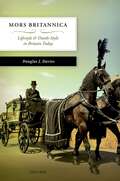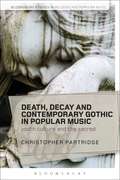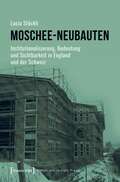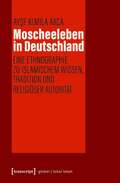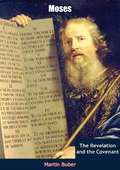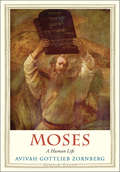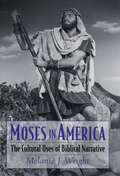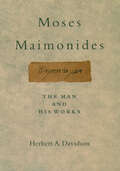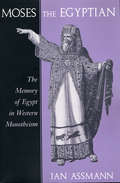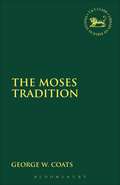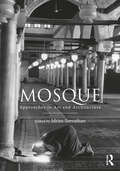- Table View
- List View
Mors Britannica: Lifestyle & Death-Style in Britain Today
by Douglas J. DaviesA people's lifestyle is one thing, their death-style another. The proximity or distance between such styles says much about a society, not least in Britain today. Mors Britannica takes up this style-issue in a society where cultural changes involve distinctions between traditional religion, secularisation, and emergent forms of spirituality, all of which involve emotions, where fear, longing, and a sense of loss rise in waves when death marks the root embodiment of our humanity. These world-orientations, evident in older and newer ritual practices, engage death in the hope and desire that love, relationships, community, and human identity be not rendered meaningless. Yet both emotions and ritual have an uneasiness to them because 'death' is a slippery topic as the twenty-first century gets under way in Britain. In this work, Douglas J. Davies draws from a largely anthropological-sociological perspective, with consideration of history, literature, philosophy, psychology, and theology, to provide a window into British life and insights into the foundation links between individuals and society, across the spectrum of traditionally religious views through to humanist and secular alternatives. He considers memorial sites (from churchyards to roadside memorials); forms of corporeal disposal (from cremation to composting); and death rites in a range of religious and secular traditions.
Mors Britannica: Lifestyle & Death-Style in Britain Today
by Douglas J. DaviesA people's lifestyle is one thing, their death-style another. The proximity or distance between such styles says much about a society, not least in Britain today. Mors Britannica takes up this style-issue in a society where cultural changes involve distinctions between traditional religion, secularisation, and emergent forms of spirituality, all of which involve emotions, where fear, longing, and a sense of loss rise in waves when death marks the root embodiment of our humanity. These world-orientations, evident in older and newer ritual practices, engage death in the hope and desire that love, relationships, community, and human identity be not rendered meaningless. Yet both emotions and ritual have an uneasiness to them because 'death' is a slippery topic as the twenty-first century gets under way in Britain. In this work, Douglas J. Davies draws from a largely anthropological-sociological perspective, with consideration of history, literature, philosophy, psychology, and theology, to provide a window into British life and insights into the foundation links between individuals and society, across the spectrum of traditionally religious views through to humanist and secular alternatives. He considers memorial sites (from churchyards to roadside memorials); forms of corporeal disposal (from cremation to composting); and death rites in a range of religious and secular traditions.
Mortality and Music: Popular Music and the Awareness of Death (Bloomsbury Studies in Religion and Popular Music)
by Christopher PartridgeThe evidence of death and dying has been removed from the everyday lives of most Westerners. Yet we constantly live with the awareness of our vulnerability as mortals. Drawing on a range of genres, bands and artists, Mortality and Music examines the ways in which popular music has responded to our awareness of the inevitability of death and the anxiety it can evoke. Exploring bereavement, depression, suicide, violence, gore, and fans' responses to the deaths of musicians, it argues for the social and cultural significance of popular music's treatment of mortality and the apparent absurdity of existence.
Mortality and Music: Popular Music and the Awareness of Death (Bloomsbury Studies in Religion and Popular Music)
by Christopher PartridgeThe evidence of death and dying has been removed from the everyday lives of most Westerners. Yet we constantly live with the awareness of our vulnerability as mortals. Drawing on a range of genres, bands and artists, Mortality and Music examines the ways in which popular music has responded to our awareness of the inevitability of death and the anxiety it can evoke. Exploring bereavement, depression, suicide, violence, gore, and fans' responses to the deaths of musicians, it argues for the social and cultural significance of popular music's treatment of mortality and the apparent absurdity of existence.
Moschee-Neubauten: Institutionalisierung, Bedeutung und Sichtbarkeit in England und der Schweiz (Kultur und soziale Praxis)
by Lucia StöckliIn den letzten Jahrzehnten sind in Europa vermehrt Moschee-Neubauten entstanden. Lucia Stöcklis religionswissenschaftliche Studie geht der Geschichte der Etablierung der Moschee-Neubauten in England und der Schweiz nach und beleuchtet ihre Bedeutung für die Muslime. Anhand bestehender und in Planung befindlicher Bauprojekte arbeitet sie gemeinsame Strukturen sowie nationale Kontexte heraus und untersucht Themen wie die Entwicklung eines multifunktionalen Zentrums, die Rolle der Frau in den Moschee-Neubauten sowie den Stellenwert der Sichtbarkeit dieser Bauten für die Muslime.
Moscheeleben in Deutschland: Eine Ethnographie zu Islamischem Wissen, Tradition und religiöser Autorität (Globaler lokaler Islam)
by Ayse Almila AkcaWelches religiöse Wissen und welche Praktiken sind in deutschen Moscheen vorzufinden? Wie legitimieren Muslim*innen islamisches Wissen als gültig bzw. ungültig und wer autorisiert dieses Wissen? Ayse Almila Akca bietet mit ihrer ethnographischen Studie tiefe Einblicke in das Moscheeleben in Deutschland und gibt spannende Antworten auf diese und weitere Fragen. Sie hinterfragt gängige Vorstellungen und analysiert religiöse Autorität, Geschlechterverhältnisse und innerislamische Kritik in deutschen Moscheen auf Basis ihrer langjährigen und intensiven Feldforschungen. Damit leistet sie einen wichtigen Beitrag, um die Entwicklungen im islamischen Feld in Deutschland besser zu verstehen.
The Moscow Pythagoreans: Mathematics, Mysticism, and Anti-Semitism in Russian Symbolism
by Ilona SvetlikovaIn Russia at the turn of the twentieth century, mysticism, anti-Semitism, and mathematical theory fused into a distinctive intellectual movement. Through analyses of such seemingly disparate subjects as Moscow mathematical circles and the 1913 novel Petersburg, this book illuminates a forgotten aspect of Russian cultural and intellectual history.
Moses: The Revelation and the Covenant
by Martin Buber“To the best of my knowledge,” writes Martin Buber of this book, “what has been essayed here is the first comprehensive attempt of its kinds.”Buber—steeped as he is in the literature of the Old Testament—here seeks to disengage history from saga and to convey the meaning of Sinai to the 20th century.“In this book a fascinating attempt is made to depict the historical Moses. The work is rich in brilliant comment. He has profound things to say on the flight of Moses to Midian, where he met with a life resembling that of his ancestors; on the Burning Bush, where he saw fire, but no form; and Moses before Pharaoh, as the first historical instance of prophet versus king; on the contrast between Moses summoned by God, and Balaam, made use of by Him. The style is invariably clear, precise and dignified. This is a book to be read, re-read and treasured.”—David Daube, Regius Professor, Oxford University
Moses: Heroic Man, Man of God (The Library of Hebrew Bible/Old Testament Studies)
by George W. CoatsDr Coats, widely recognized for his work over two decades on the Pentateuchal traditions, here presents us with his distinctive portrait of Moses. George Coats identifies two strands in the Moses tradition, the tradition of the hero who represents the people of God, and that of the 'man of God', distinctly unheroic in folkloristic terms, who represents God to the people. This duality in the portrayal of Moses becomes evident already in the call narrative of Exodus 3, a narrative that should not be divided between J and E but reflects the most ancient perception of the character Moses and his significance.
Moses: A Human Life (Jewish Lives)
by Avivah Gottlieb ZornbergAn unprecedented portrait of Moses's inner world and perplexing character, by a distinguished biblical scholar No figure looms larger in Jewish culture than Moses, and few have stories more enigmatic. Avivah Gottlieb Zornberg, acclaimed for her many books on Jewish thought, turns her attention to Moses in this remarkably rich, evocative book. Drawing on a broad range of sources—literary as well as psychoanalytic, a wealth of classical Jewish texts alongside George Eliot, W. G. Sebald, and Werner Herzog—Zornberg offers a vivid and original portrait of the biblical Moses. Moses's vexing personality, his uncertain origins, and his turbulent relations with his own people are acutely explored by Zornberg, who sees this story, told and retold, as crucial not only to the biblical past but also to the future of Jewish history.
Moses as a Character in the Fourth Gospel: A Study of Ancient Reading Techniques (The Library of New Testament Studies #229)
by Stanley HarstineDid first century Mediterranean readers of the Fourth Gospel have comparable literary examples to inform their comprehension of Moses as a character? In addressing this question, Harstine's study falls into two parts. The first is an analysis of the character Moses as utilized in the text of the Fourth Gospel. The second is an examination of other Hellenistic narrative texts, in which the character of Homer is also considered, as another important legendary figure with whom the readers of the Fourth Gospel would have been familiar.
Moses Hirschel and Enlightenment Breslau: A City and its Jews in the Late Eighteenth Century
by David Heywood JonesBreslau has been almost entirely forgotten in the Anglophone sphere as a place of Enlightenment. Moreover, in the context of the Jewish Enlightenment, Breslau has never been discussed as a place of intercultural exchange between German-speaking Jewish, Protestant and Catholic intellectuals. An intellectual biography of Moses Hirschel offers an excellent case-study to investigate the complex reciprocal relationship between Jewish and non-Jewish enlighteners in a prosperous and influential Central European city at the turn of the 18th century.
Moses Hirschel und die Breslauer Aufklärung: Eine Stadt und ihre Juden im späten achtzehnten Jahrhundert
by David Heywood JonesBreslau ist im englischsprachigen Raum als Ort der Aufklärung fast völlig in Vergessenheit geraten. Darüber hinaus ist Breslau im Kontext der jüdischen Aufklärung nie als Ort des interkulturellen Austauschs zwischen deutschsprachigen jüdischen, protestantischen und katholischen Intellektuellen diskutiert worden. Eine intellektuelle Biographie von Moses Hirschel bietet ein hervorragendes Fallbeispiel, um die komplexen wechselseitigen Beziehungen zwischen jüdischen und nichtjüdischen Aufklärern in einer wohlhabenden und einflussreichen mitteleuropäischen Stadt an der Wende zum 18. Jahrhundert zu untersuchen.Die Übersetzung aus dem Englischen wurde mit Hilfe von künstlicher Intelligenz (anhand einer maschinellen Übersetzung durch einen Service von DeepL.com) angefertigt. Der Autor hat den Text durchgesehen, um die inhaltliche Richtigkeit des Werkes zu prüfen und gegebenenfalls Anpassungen vorzunehmen.
Moses in America: The Cultural Uses of Biblical Narrative (AAR Cultural Criticism Series)
by Melanie J. WrightThis book explores the retelling of the life of Moses in three 20th-century American narratives: Moses in Red, by Lincoln Steffens; Moses, Man of the Mountain, by Zora Neale Hurston; and Cecil B. DeMille's film, The Ten Commandments. Wright's analysis reveals that the figure of Moses has strong currency in American culture at many levels.
Moses Maimonides: The Man and His Works
by Herbert DavidsonMoses Maimonides (1137/38-1204), scholar, physician, and philosopher, was the most influential Jewish thinker of the Middle Ages. In this magisterial biography, Herbert Davidson provides an exhaustive guide to Maimonides' life and works. After considering Maimonides' upbringing and education, Davidson expounds all of his many writings in exhaustive detail, with separate chapters on rabbinic, philosophical, and medical texts. Moses Maimonides has been recognized as the standard work on a towering figure of Western intellectual history.
Moses Maimonides: The Man and His Works
by Herbert DavidsonMoses Maimonides (1137/38-1204), scholar, physician, and philosopher, was the most influential Jewish thinker of the Middle Ages. In this magisterial biography, Herbert Davidson provides an exhaustive guide to Maimonides' life and works. After considering Maimonides' upbringing and education, Davidson expounds all of his many writings in exhaustive detail, with separate chapters on rabbinic, philosophical, and medical texts. Moses Maimonides has been recognized as the standard work on a towering figure of Western intellectual history.
Moses Mendelssohn: A Biographical Study (The Littman Library of Jewish Civilization)
by Alexander AltmannAlexander Altmann’s acclaimed, wide-ranging biography of Moses Mendelssohn (1729–96) was first published in 1973, but its stature as the definitive biography remains unquestioned. In fact, there has been no subsequent attempt at an intellectual biography of this towering and unusual figure: no other Jew so deeply rooted in the Jewish tradition was at the same time so much a part of the intellectual life of the German Enlightenment in the second half of the eighteenth century. As such, Moses Mendelssohn came to be recognized as the inaugurator of a new phase in Jewish history; all modern Jews today are in his debt. Altmann presents Moses Mendelssohn in strictly biographical terms. He does not attempt to assess his significance with the hindsight of historical perspective nor to trace his image in subsequent generations, but rather to observe his life from the period within which it was set. Altmann has written an absorbing and compelling narrative that makes a whole epoch come alive with great drama, for Mendelssohn’s life was a kaleidoscope of the European intellectual scene, Jewish and non-Jewish. As both a prominent philosopher and a believing Jew, Mendelssohn became a spokesman for the Jews and Judaism; he was one of the rare figures who become the symbol of an era. Through Altmann’s skilful use of hitherto unpublished archival material, the reader is introduced to the vast array of people—men of letters, artists, politicians, scientists, philosophers, and theologians—with whom Mendelssohn was in contact, and sometimes in conflict. What was Mendelssohn’s Judaism like? To what extent did the disparate worlds of Judaism and modern Enlightenment jostle each other in his mind and to what degree could he harmonize them? These questions are not easily answered, and it is only in the aggregate of a multitude of accounts of experiences, reaction, and statements on his part that the answer is to be found. Alexander Altmann’s analysis of this wealth of material is extraordinary in its discernment, subtlety, and clarity of expression. This masterly work will be of interest not only to those who are concerned with Jewish intellectual history but also to those interested in eighteenth-century cultural and social history, philosophy and theology, literary criticism, aesthetics, and the other areas of intellectual activity in ferment at that time. The general reader will also find much of contemporary relevance in Mendelssohn’s life, not only because of his exemplary devotion to reason and tolerance, but also because of his lifelong struggle with the basic dilemma of the Jew in the modern world: the attraction of assimilation versus the singularity of Jewish life, and the preservation of Jewish identity versus integration in the wider society.
Moses the Egyptian: The Memory Of Egypt In Western Monotheism
by Jan Assmann"Standing at the very foundation of monotheism, and so of Western culture, Moses is a figure not of history, but of memory. As such, he is the quintessential subject for the innovative historiography Jan Assmann both defines and practices in this work, the study of historical memory—a study, in this case, of the ways in which factual and fictional events and characters are stored in religious beliefs and transformed in their philosophical justification, literary reinterpretation, philological restitution (or falsification), and psychoanalytic demystification. To account for the complexities of the foundational event through which monotheism was established, Moses the Egyptian goes back to the short-lived monotheistic revolution of the Egyptian king Akhenaten (1360–1340 B.C.E.). Assmann traces the monotheism of Moses to this source, then shows how his followers denied the Egyptians any part in the origin of their beliefs and condemned them as polytheistic idolaters. Thus began the cycle in which every “counter-religion,” by establishing itself as truth, denounced all others as false. Assmann reconstructs this cycle as a pattern of historical abuse, and tracks its permutations from ancient sources, including the Bible, through Renaissance debates over the basis of religion to Sigmund Freud’s Moses and Monotheism. One of the great Egyptologists of our time, and an exceptional scholar of history and literature, Assmann is uniquely equipped for this undertaking—an exemplary case study of the vicissitudes of historical memory that is also a compelling lesson in the fluidity of cultural identity and beliefs."
The Moses Tradition (The Library of Hebrew Bible/Old Testament Studies)
by George W. CoatsThese essays from the doyen of Moses studies focus on issues primarily in Pentatuchal/Hexateuchal research. The volume, containing several papers previously unpublished, forms a companion volume to Coats's 'Moses: Heroic Man, Man of God'. Together the two volumes comprise the whole of Coats's unique and wide-ranging investigations of the figure of Moses.
A Moslem Saint of the Twentieth Century: Shaikh Ahmad Al-'Alawī His Spiritual Heritage and Legacy (Ethical and Religious Classics of East and West #4)
by Martin LingsDrawing on first-hand sources which had been inaccessible to Western readers at the time this book was originally published in 1961, this book gives a vivid picture of life in an order of Muslim mystics or Sufis. Against this background stands the unforgettable figure of the Algerian Shaikh who was head of the order from the death of his Master in 1909 until his own demise in 1934. The last chapters are devoted to his writings, which include some remarkable mystic poems.
A Moslem Saint of the Twentieth Century: Shaikh Ahmad Al-'Alawī His Spiritual Heritage and Legacy (Ethical and Religious Classics of East and West #4)
by Martin LingsDrawing on first-hand sources which had been inaccessible to Western readers at the time this book was originally published in 1961, this book gives a vivid picture of life in an order of Muslim mystics or Sufis. Against this background stands the unforgettable figure of the Algerian Shaikh who was head of the order from the death of his Master in 1909 until his own demise in 1934. The last chapters are devoted to his writings, which include some remarkable mystic poems.
Mosque: Approaches to Art and Architecture
by Idries TrevathanMosque examines the history, culture, evolution and functions of the Muslim house of worship through the prism of its artistic objects and architectural elements. Contributors present a range of elements, from dome to mihrab, to mosque furniture including lamps, prayer rugs and Qur’an stands. In addition, the book draws attention to the importance of mosque heritage through special projects and initiatives that study, preserve and revitalize the traditional arts of the mosque. This unique book brings together prominent architects, art historians, artists, historians and curators to explore innovative approaches towards the study of mosques through the presentation of original research and insights about mosque-related cultural objects. It is essential reading for anyone interested in the art and culture of the Muslim world.
Mosque: Approaches to Art and Architecture
Mosque examines the history, culture, evolution and functions of the Muslim house of worship through the prism of its artistic objects and architectural elements. Contributors present a range of elements, from dome to mihrab, to mosque furniture including lamps, prayer rugs and Qur’an stands. In addition, the book draws attention to the importance of mosque heritage through special projects and initiatives that study, preserve and revitalize the traditional arts of the mosque. This unique book brings together prominent architects, art historians, artists, historians and curators to explore innovative approaches towards the study of mosques through the presentation of original research and insights about mosque-related cultural objects. It is essential reading for anyone interested in the art and culture of the Muslim world.
Mosques in the Metropolis: Incivility, Caste, and Contention in Europe
by Elisabeth BeckerMosques in the Metropolis offers a unique look into two of Europe’s largest mosques and the communities they support. Elisabeth Becker provides a complex picture of Islam in Europe at a particularly fraught time, shedding light on both experiences of deep and enduring marginalization and the agency of Muslim populaces. She balances individual Muslim voices with the historical and structural forces at play, revealing, in all their complexity, the people for whom the mosques are centers of religion and community life. As her interlocutors come to life in the pages, the metropolis emerges as a space alternative to the nation in which they can contend with degrading images of Islam and Muslims. Ultimately Becker insists that caste is a crucial lens through which to view Muslims in Europe, and through this lens she critiques what she perceives as the failures of European pluralism. To amplify her point, she brings Jewish history and twentieth-century Jewish thought into the conversation directly, drawing on scholars such as Walter Benjamin, Zygmunt Bauman, and Hannah Arendt to describe both Jewish and Muslim life and marginality. By challenging Eurocentric notions, from “progress” to “civility,” “tolerance” to “freedom” and “equality, what is at stake, Becker insists, is the possibility of a truly plural Europe.
